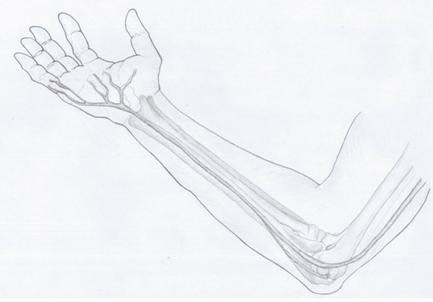Cubital Tunnel Syndrome
Common Symptoms Of Cubital Tunnel Syndrome
- Numbness or tingling, “pins and needles” in the little and ring fingers, usually worse on waking up in mornings or when doing things with the elbows flexed (eg reading a book, using a tablet, working on computer)
- Weakness or clumsiness in the hand
- Easily dropping things or feeling tired or “cramps” in the hand
- Difficulty with using chopsticks
- Difficulty picking up and using small objects (eg turning a key, picking coins, buttoning up)
- Little and ring fingers becoming bent and difficult to straighten
- Difficulty bringing the fingers together when they are extended
- Shrinking of the hand muscles, causing more hollow spaces in the hand
Wasting away of hand muscles with hollowing of the hand and difficulty bringing the fingers together. The little and ring fingers are also unable to straighten fully.
Cause Of Cubital Tunnel Syndrome
The ulnar nerve is a large nerve that goes from the arm, across the back of the elbow, down the forearm and into the hand. This nerve carries signals for sensation from the little and ring fingers and part of the hand back to the brain. It also carries signals from the brain to activate the small muscles in the hand, which are important for strong gripping, pinching and fine control of the fingers.

As the nerve goes behind the elbow, it is goes through a narrow space called the cubital tunnel, with a band of tissue going across to hold the nerve in place. In some people, this space becomes narrower than usual because of bone spurs (osteoarthritis) or thickening of the band of tissue. This increases the pressure on the nerve as it goes through the cubital tunnel, affecting its ability to conduct signals properly. When the elbow is flexed, the pressure increases further. This “conduction block” causes the numbness or tingling in the fingers and weakness of the muscles in the hand. The symptoms are initially mild and go away quickly when the elbow is straightened and the hand is shaken vigourously. Eventually, over several months to years, the numbness and tingling become more constant and the muscles in the hand start to shrink and the hand develops more sunken or hollow spaces where the muscles used to be. The hand becomes much weaker and there is difficulty doing things that require dexterity and fine finger movements such using chopsticks, keys and buttons. Because the small muscles also help to straighten the little and ring fingers and bring them together, these fingers become bent and separated from the rest of the fingers.
Diagnosis Of Cubital Tunnel Syndrome
If you have these symptoms, see a hand specialist for a full neurological examination and some investigations. These investigations include:
- Neck x-ray to look for any arthritis or extra ribs in the neck, which can compress the nerves that form the ulnar nerve at the neck level (see the information page on Thoracic Outlet Syndrome)
- Elbow x-ray to look for arthritis of the elbow, or any abnormal bone shape due to previous injury
- Nerve conduction tests to check how well the nerve conducts electricity across different parts of the arm and forearm
Treatment Of Cubital Tunnel Syndrome
In the early stages of cubital tunnel syndrome, it may be possible to minimize pressure and tension on the nerve by not keeping the elbow flexed for too long when doing things with the hands. Physical therapy with “nerve gliding exercises” to loosen the nerve at the elbow helps to relieve the tightness. A splint is used at night to keep the elbow straight while sleeping.
In more severe or later stages, especially when there is weakness of the hand muscles, surgery is needed. The ulnar nerve behind the elbow and in the forearm is completely freed from any bands of tissue that are crossing it, thus relieving any compression and pressure on the nerve. This is usually done with a 10cm long incision across the back of the elbow to expose the nerve in this area. It can also be done by a minimally invasive procedure (endoscopic cubital tunnel release) with a 2-3cm incision using a camera and special equipment. Following this release, the nerve may become very loose and keep slipping across the bone at the elbow. If this happens, the nerve has to be secured in front of the elbow either under the forearm muscles (submuscular anterior transposition) or under a sling of tissue on the muscles (subfascial anterior transposition). This decreases pressure and tension on the nerve when the elbow flexes, and prevents it from becoming injured by frequent rubbing against the bone during elbow movements. Following surgery, nerve gliding exercises are started to keep the nerve moving and to prevent it from getting stuck in scar tissues.

Not sure if you’re experiencing signs and symptoms of cubital tunnel syndrome? Speak to our hand care team to find out if this is the medical condition you have at +65 6733 9093. Or book an appointment with our hand specialists for a consultation on your symptoms and treatment options.

 Area of numbness or tingling sensations
Area of numbness or tingling sensations
 Area of numbness or tingling sensations
Area of numbness or tingling sensations